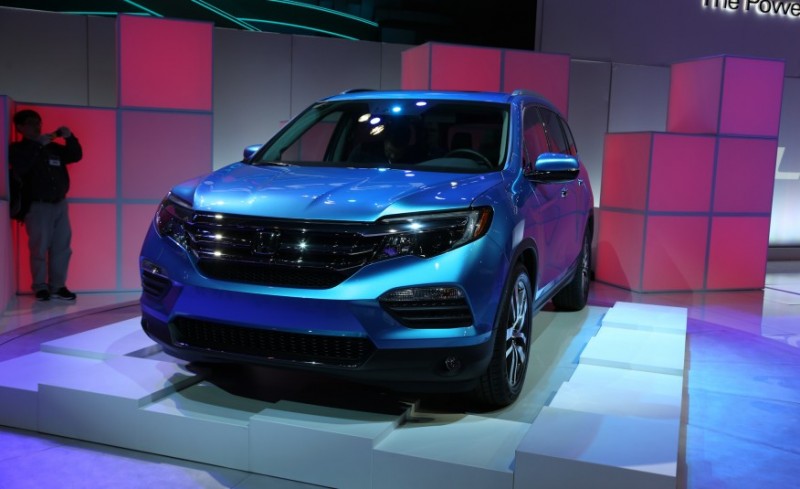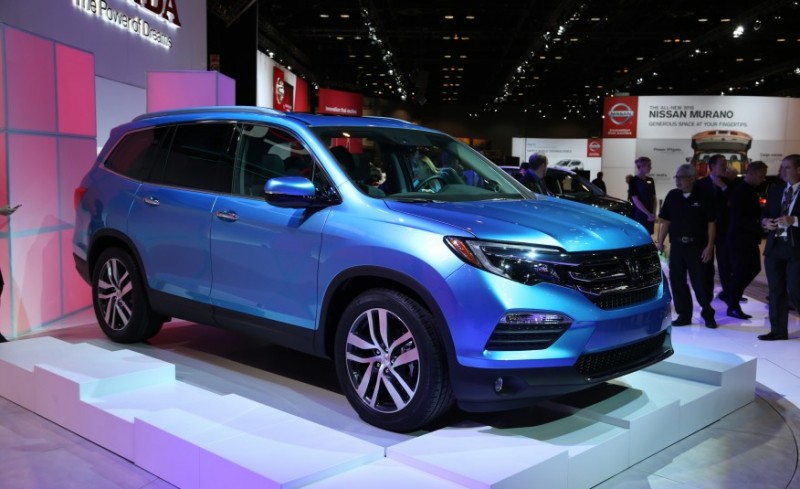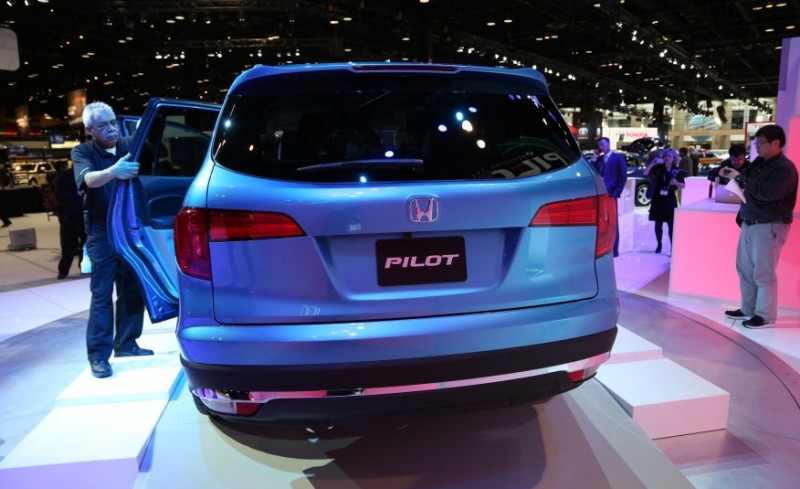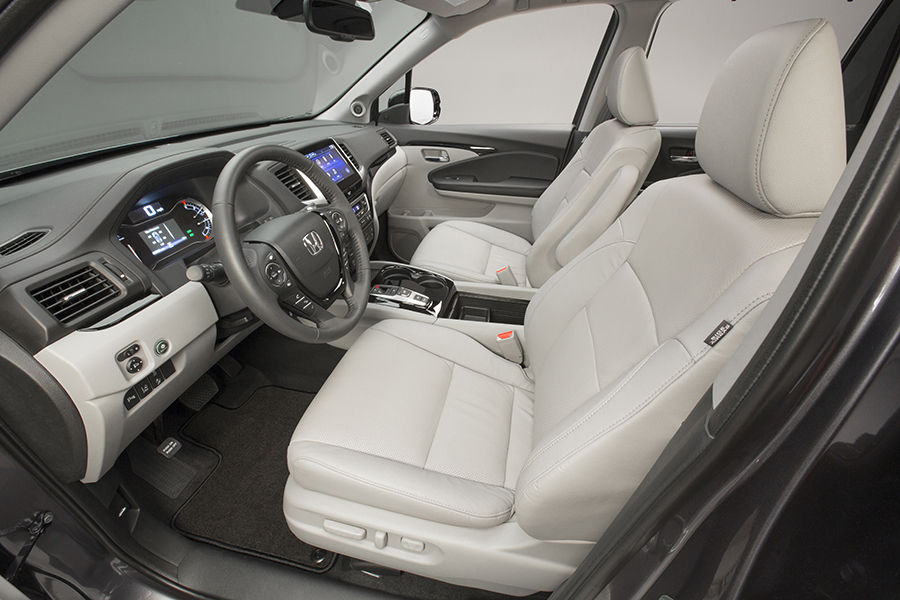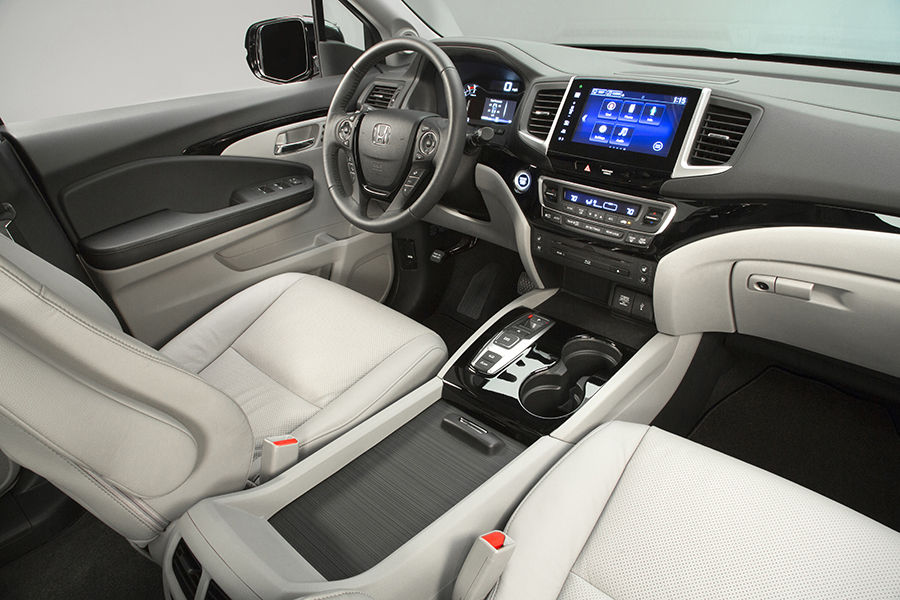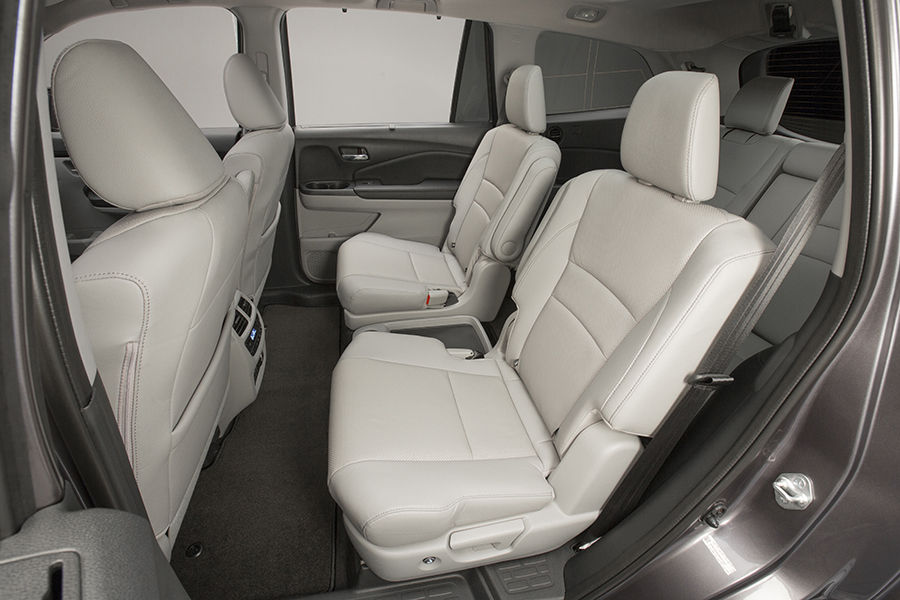What’s New for 2016
The Pilot is completely redesigned for the 2016 model year.
Introduction
Big and blocky on the outside but underneath just a roomy, family-friendly crossover, the previous-generation Honda Pilot perhaps tried a little too hard to look like something it wasn’t. It was like Sheldon from The Big Bang Theory gearing up in full Under Armour apparel to fake his way into an iron man competition. This time around, the fully redesigned 2016 Honda Pilot has a more traditional crossover appearance. It’s probably a more honest approach, and it’s backed up by new improvements that have made this third-generation Pilot a better choice for a three-row large crossover than ever before.
Honda focused much of its attention to the Pilot’s interior, which is more modern, more refined and easier to see out of. The Pilot was always roomy and versatile, but extra leg- and headroom in the third row, in particular, makes it friendlier for passengers of all sizes. There are also more bins and cupholders for your personal items. Up front, a new 8-inch touchscreen interface brings the Pilot up to date in terms of technology features and controls. The screen, standard on all but the base LX, gives the Pilot’s dash a clean look, though it’s not intuitive or responsive to use as some other touchscreen systems.
The rest of the cabin benefits from improved, softer materials and additional acoustic materials that quell noise. Honda also adds a top-of-the-line Elite model this year that is loaded with such features as a panoramic sunroof, heated and ventilated front seats, heated second-row captain’s chairs and a heated steering wheel. Even if you don’t get the Elite, though, Honda is offering a new collection of safety features (available on all but the base LX) that includes forward collision mitigation and lane departure prevention.
The ride and handling are also improved thanks to a stiffer structure made with more high-strength steel and a weight reduction of about 250 pounds. The smooth ride is worthy of a luxury car, and although handling still isn’t sporty, it’s controlled and the sophisticated all-wheel-drive system provides impressive traction around corners (not to mention snow, mud or sand). The reduced weight also teams with a pair of new transmissions and 30 extra horsepower to raise fuel economy and provide more willing thrust.
As a result of the 2016 changes, the Honda Pilot is now one of the best large crossovers. However, there are several strong choices. The Toyota Highlander has been our top-rated choice with strengths that closely mirror those of the well-rounded Pilot. If space is your major concern, the Chevrolet Traverse can’t be beat. The wagonlike Ford Flex is equal parts stylish and versatile, while the Hyundai Santa Fe stands out for its value. Each are worth a look, and while we will need more time with the new Pilot to declare it a class leader, its well-rounded attributes (not to mention Honda’s reputation for reliability and high resale values) make it seem like a pretty good place to start when searching for a large family SUV.
Body Styles, Trim Levels, and Options
The Pilot is a three-row crossover SUV. It is offered in LX, EX, EX-L, Touring and the new Elite trim levels. All seat eight people with the exception of the Elite, which has second-row captain’s chairs that reduce capacity to seven.
Standard features of the LX model include 18-inch alloy wheels, rear privacy glass, air-conditioning, cruise control, a tilt-and-telescoping steering wheel, active noise cancellation, and a 60/40-split folding third-row seat. Electronic features include a seven-speaker sound system, a rearview camera, Bluetooth phone and audio connectivity, an auxiliary audio jack and a USB port.
The EX model adds automatic headlights, fog lights, LED running lights, heated mirrors, keyless ignition and entry, the Honda Lane Watch blind-spot camera, three-zone automatic climate control, an eight-way power adjustable driver seat (with two-way power lumbar), the 8-inch touchscreen interface, HondaLink smartphone-enabled features and an upgraded seven-speaker sound system with two additional higher powered USB ports, satellite radio and Pandora Internet radio control. Also included is the Intelligent Traction Management system that adds a Snow mode for the front-drive version and Snow/Sand/Mud modes with AWD.
The EX-L gets a sunroof, a power tailgate, a leather-wrapped steering wheel, leather upholstery, one-touch sliding second-row seats, a four-way power adjustable front passenger seat, heated front seats and an auto-dimming rearview mirror.
The Honda Sensing package available on the EX and EX-L adds adaptive cruise control, a forward collision mitigation automatic braking system, a road departure intervention system, a forward collision warning system, and lane departure warning and intervention systems. The EX-L can also be equipped with a navigation system or a rear entertainment system that includes a single overhead screen, HDMI and RCA ports, two additional USB ports for the second row, and a 115-volt power outlet. Note that these EX-L options cannot be had in combination with each other.
All of these EX-L options come standard on the Touring, which further adds roof rails, a nine-speed automatic transmission, automatic engine start/stop, front and rear parking sensors, driver memory settings, second-row sunshades and a 10-speaker sound system.
The top-of-the-line Elite model further adds 20-inch wheels, LED headlights, automatic high-beam headlight control, a blind-spot monitor with rear cross traffic alerts (replaces LaneWatch), automatic windshield wipers, a panoramic sunroof, heated and ventilated front seats, heated second-row captain’s chairs (reduces maximum seating to seven people), a heated steering wheel and HD radio.
Powertrains and Performance
Every 2016 Honda Pilot comes with a 3.5-liter V6 good for 280 horsepower and 262 pound-feet of torque. LX, EX, and EX-L models are equipped with a six-speed automatic transmission, while the Touring and Elite get a nine-speed automatic with steering wheel shift paddles and an automatic stop/start system.
Front-wheel drive is standard. The optional all-wheel-drive system not only sends power front and back, but also between the left and right wheels for improved handling. On EX trims levels and above there are also Snow, Mud and Sand settings that maximize the effectiveness of various vehicle systems in low-traction scenarios.
Honda says it expects estimated fuel economy ratings to be 22 mpg combined (19 city/27 highway) with front-drive and the six-speed. They are 23 combined (20 city/27 highway) with front-drive and the nine-speed. Opting for all-wheel drive lowers each estimate by 1 mpg.
When properly equipped, front-drive models can tow up to 3,500 pounds, while AWD models can pull 5,000 pounds.
Safety
Standard safety features of the 2016 Honda Pilot include antilock brakes, traction and stability control, front side airbags, side curtain airbags and a rearview camera. The Honda Lane Watch blind-spot camera is standard on the EX, EX-L and Touring, while the Elite gets a blind-spot warning system with rear cross traffic alerts. The Touring and Elite also come with front and rear parking sensors. Available for EX and EX-L and standard on Touring and Elite is the Honda Sensing package that includes forward collision warning, a forward collision mitigation system with automatic braking, road departure intervention, and lane departure warning and intervention systems.
Interior Design and Special Features
The 2016 Honda Pilot has the most versatile interior this side of a minivan. There is a multitude of handy bins and twice as many cupholders as seats, while the maximum cargo capacity of 83.9 cubic feet is competitive with most competitors. Importantly, the area behind the third row benefits from a removable floor panel that frees up a useful amount of storage space when all seats are in use.
A special feature for the Pilot are second-row seats that tilt and slide forward with the push of a button (standard EX-L and above). It’s handy since it reduces the strength and effort needed to move the seat, but the resulting pass through area is still on the small side of the segment. Many competitors still make it easier to climb into the third row, but once back there, those in the Pilot should find more room than most. Two adults of most sizes or three kids will find generous headroom and decent legroom.
Interior quality takes a leap forward with this generation. Soft-touch surfaces replace hard plastics on the dash and door panels, giving the 2016 Pilot an upscale ambiance. The control interface is also updated and simplified. Most trims now feature an 8-inch touchscreen that handles the entertainment, communications, and navigation functions. It’s not our favorite interface, as we’ve found it can be slow to respond to inputs and could really use a volume knob instead of a touch-activated control. The climate controls are, thankfully, separate and very easy to use.
Driving Impressions
Despite being appreciably more spacious and functional inside than most competitors, the Pilot is actually smaller and lighter than them as well. This relatively low weight combines with a stiffer structure to make the 2016 Honda Pilot feel impressively solid, controlled and less cumbersome than you might expect for this segment of generous girth. The ride is noteworthy for its ability to soak up bumps, even on the Elite’s 20-inch wheels, and maintain its composure through turns. Plus, the Pilot’s reasonably precise steering and trick “torque-vectoring” all-wheel-drive system (it shunts power left and right to help power the vehicle around turns) provide the driver with a commendable amount of agility.
Low weight is also a benefit to the 3.5-liter V6 engine, which boasts 30 more horsepower than its predecessor. The 2016 Pilot gets moving with ease and has enough in reserve to provide passing punch when needed. Lower-end models come with a competent six-speed automatic transmission that shifts smoothly, but downshifts are a little more dramatic with a greater change in engine speed (and noise) when it comes time to pass compared to the nine-speed found in the Touring and Elite. We didn’t observe any of the hesitation and gear-hunting usually associated with nine-speed transmissions, and found its auto stop/start system to be pleasantly unobtrusive; but further testing, especially in traffic would be needed to render a more complete verdict.
Source: Edmunds

